Raised beds have a lot of advantages. Building a raised bed is quite challenging, but once you make it, you get multiple benefits from it for your plants. But, a common question that arises is whether the beds will require drainage or not.
Raised beds will require proper drainage to prevent overwatering, water pooling, and root rot and keep the plants healthy in the long run. If your bed is below the knee level, it won’t require special drainage, but beds above the knee level will need additional measures to ensure good drainage.
This guide will give you detailed knowledge about drainage requirements in raised beds and how to make a proper drainage system for raised beds.
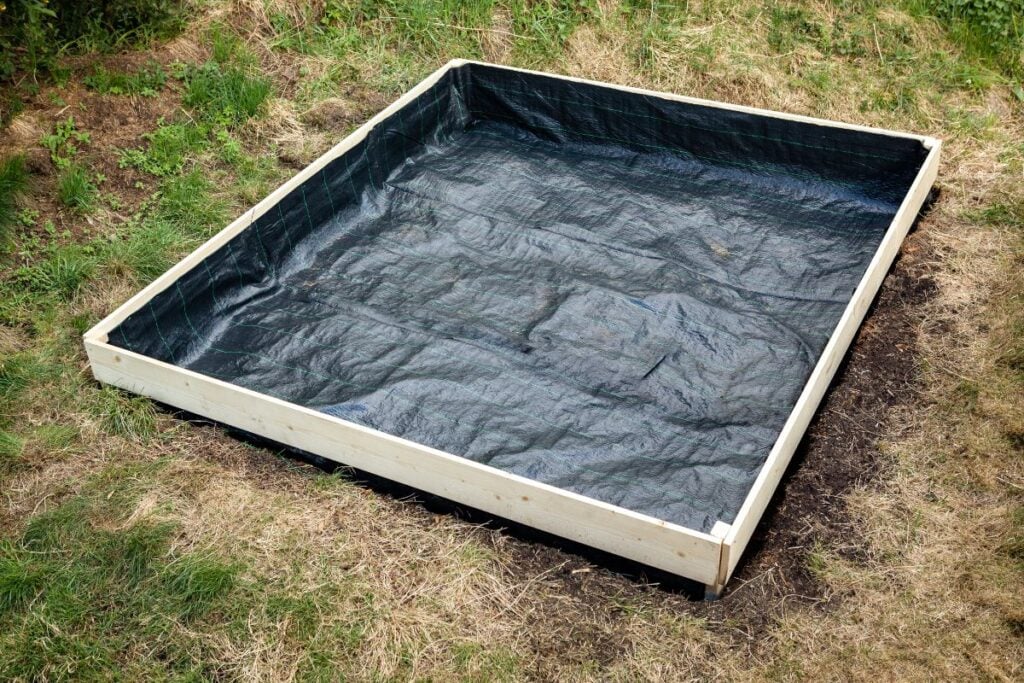
Do the raised beds need drainage?
There are multiple advantages to having raised beds.
They make the garden look attractive and add aesthetic value to it.
Gardening is easier in raised beds because beds can improve drainage and control weed growth.
But, you must take certain steps to create better drainage to obtain good drainage and healthy plants.
Creating proper drainage in the raised beds by adding drainage materials will greatly improve the bed’s drainage.
Sufficient drainage allows the water to flow off the bed instead of sitting in the soil and creating a pool of water.
There are two maiden reasons for which the raised beds must have a proper drainage system:
- To prevent overwatering, root rot, and waterlogging
- To keep the soil in good condition
Raised beds somewhat act like pots.
The difference is pots are way much smaller than the beds and hold limited space compared to the raised beds.
If the raised beds lack proper drainage, it will give rise to various issues like overwatering, root rot, pests, and diseases.
Prolonged moist conditions in the soil will further create an anaerobic atmosphere, especially during the heavy and long rainy seasons.
Such conditions will make the plants difficult to breathe.
Good soil that drains very well can be quite expensive.
But with a proper drainage system, you can even improve the drainage in cheap soil.
With the help of a few cheap drainage materials, you can increase the drainage in the soil of your raised beds.
Besides, it is easy and economical.
Do all the raised beds need drainage?
Before you add drainage materials to your raised beds, confirm whether your bed needs drainage or not.
You must check whether your bed is above or below the knee level.
And, to create a bed below or above the knee level, you must learn whether the plants or veggies you are growing are deep-rooted or shallow-rooted.
Plants that don’t have very deep roots don’t require very deep beds.
Their beds can be at knee level.
On the contrary, some deep-rooted plants and vegetables need knee-level raised beds or above.
The deeper beds will need much more drainage systems than the shallow ones.
Landscapes with slope areas will also require proper drainage because uneven beds absorb water differently.
Some areas have no water, whereas others create a pool of water due to gravity.
In that case, you must ensure the bed leveling and the drainage.
How much drainage does a raised bed require?
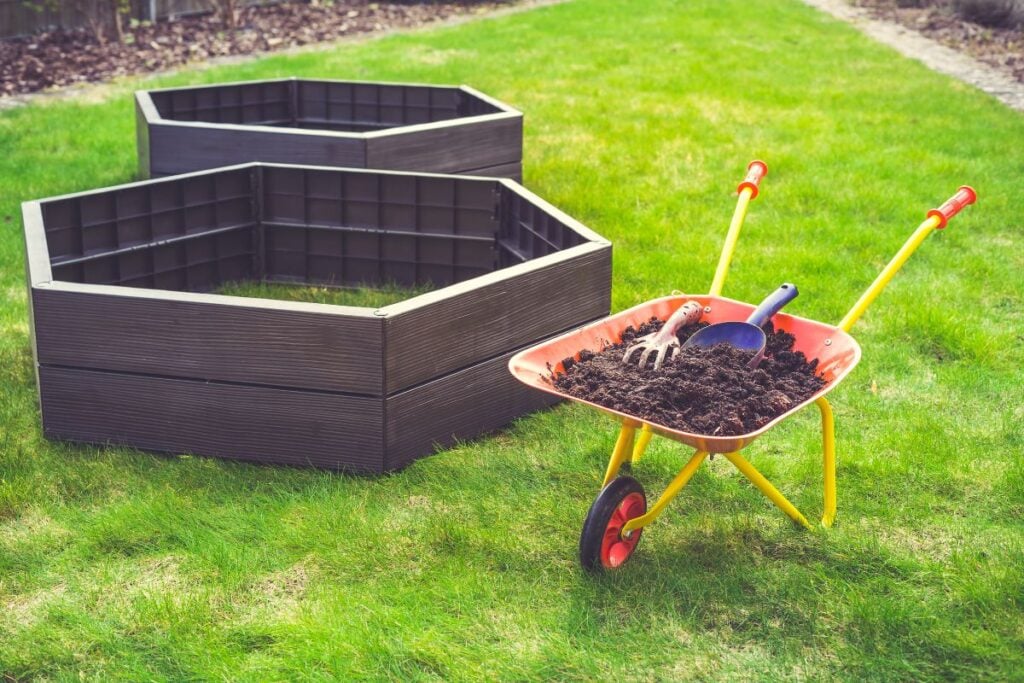
If you know the actual height of your raised beds, you can determine the amount of drainage space needed by your bed.
For example, if your bed is 30 inches deep, you need to fill 15 inches of the bed with soil and keep the rest 15 inches of space for drainage.
To find out how much drainage materials are required for your bed, find out the volume of your bed first, especially the depth of the bed.
Don’t worry if the bed is full.
The soil will sink over time, and the level will reduce.
When you add drainage materials and mulch the bed with organic matter, you may feel that the bed has become very compact.
After 1-2 years, the compactness will disappear.
What types of drainage materials do you need for raised beds?
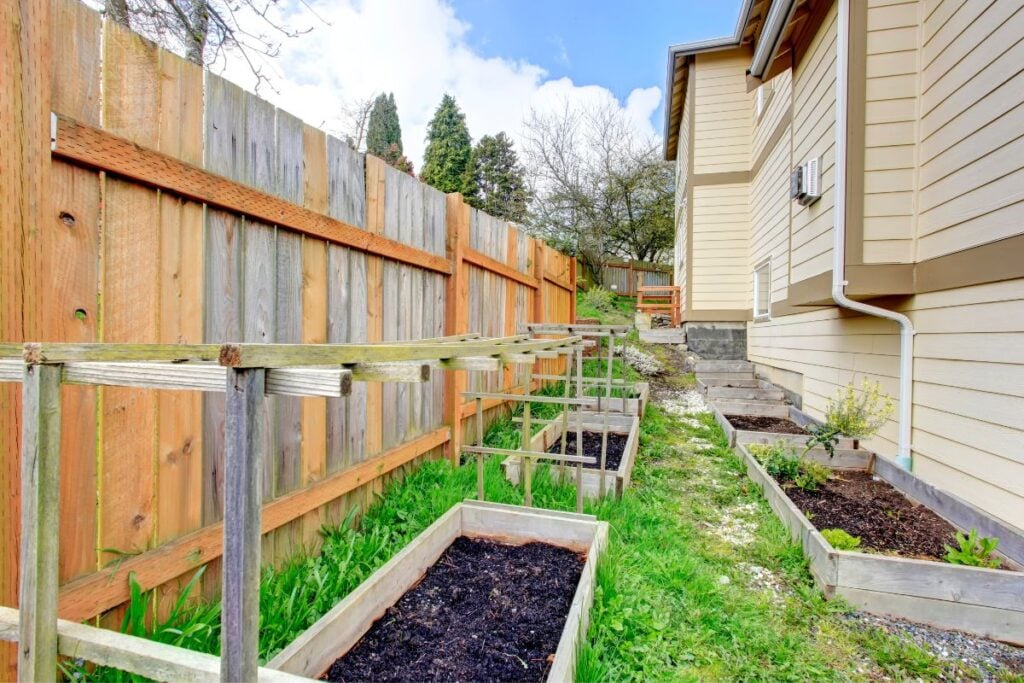
Many drainage materials are available for raised beds.
Some work averagely, and some are great.
Here are some good and affordable materials for drainage:
- Crushed granite: The material is easy to handle and gives excellent results. It doesn’t matter if it gets mixed with the topsoil.
- Sand: Sand is another great material for drainage. But, one drawback is it contains salty materials. So, wash it very well before you use it to remove the salt properties. If it gets mixed with the topsoil, the plants or the vegetables won’t grow well.
- Pebbles, stones, rock, or gravel: Though these materials are good for drainage, the topsoil can leach into the rocks and limit the drainage. Besides, turning over the soil with these materials is quite hard.
While placing the rocks or pebbles, ensure the level is around 3 inches deep.
However, you can add a little more to raise the garden bed.
Once you put these drainage materials at the bottom of the bed, you can fill the bed with soil.
These materials will allow the water to drain out of the bed and prevent the soil from being compact.
Other drainage materials include compost, manure, perlite, and vermiculite.
How can I test the soil for drainage?
When you put raised beds on the soil surface, understanding the drainage beneath the bed is very important.
If you use well-drained soil in the bed, the water will drain well and accumulate at the bottom of the bed.
But, if the ground soil doesn’t have good drainage, the water will stand still at the bottom or take a lot of time to drain.
On the contrary, if the soil beneath the bed is also well-drained, then water will not accumulate.
To check this, dig a hole around one foot at the place where you want to keep the bed and fill it with water.
Wait for 1-2 days and check if the water is standing or has disappeared.
If there is no water, fill it again.
If the water is standing, wait for some more time until the water disappears.
To allow the soil to drain the water well, till the soil properly before placing the beds.
It will make the soil flexible and drainage easy.
Along with raised beds, the soil under the bed should also be able to drain water well.
Otherwise, the plants will suffer from overwatering and root rot.
Most of the plants’ health will start deteriorating in such conditions.
Looking for gardening supplies? We have tested 100's of products before recommending them to you guys. Check out our best pick below:
| Image | Gardening Supplies | Best Price? |
|---|---|---|
 Top
Top Top
Top | Raised Garden Bed Kit | Check On Amazon |
 | XLUX Soil Moisture Meter, Plant Water Monitor, Soil Hygrometer Sensor for Gardening, Farming, Indoor and Outdoor Plants, No Batteries Required | No Results |
 Top
Top Top
Top | 82 Pcs Garden Tools Set and Extra Succulent Tools Set | Check On Amazon |
 | Joeys Garden Expandable Garden Hose with 8 Function Hose Nozzle, Lightweight Anti-Kink Flexible Garden Hoses, Extra Strength Fabric with Double Latex Core, (50 FT, Black) | No Results |
 Top
Top Top
Top | Dual Chamber Compost Tumbler | Check On Amazon |
 Top
Top Top
Top | Sunnyglade Plant Stakes | Check On Amazon |
 Top
Top Top
Top | Organic Cold Pressed Neem Seed Oil | Check On Amazon |
 Top
Top Top
Top | Mighty Mint Gallon :-Insect and Pest Control Peppermint Oil | Check On Amazon |
 Top
Top Top
Top | Scotts DiseaseEx Lawn Fungicide | Check On Amazon |
 Top
Top Top
Top | Jacks Classic 20-20-20 All Purpose Fertilizer | Check On Amazon |
 Top
Top Top
Top | 30,000 Seeds Pollinator Attracting Wildflower Mixture | Check On Amazon |
 Top
Top Top
Top | Survival Vegetable Seeds Garden Kit-Over 16,000 Seeds | Check On Amazon |
Other considerations affecting the drainage of raised beds
Certain situations will affect the drainage of the raised beds. Below are the factors:
Beds with floor base
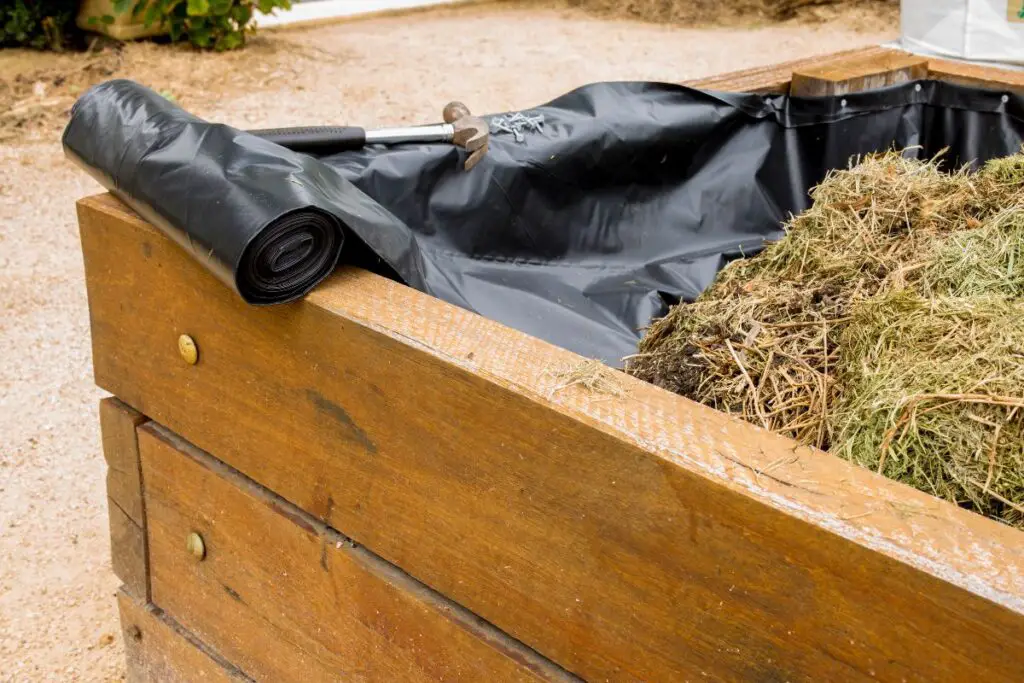
If your raised bed has a base and is not open to the ground, you must use some drainage materials to improve the drainage.
Some raised beds come with a base, and these beds work like pots. These beds have drainage holes like the pots.
But, the holes get clogged due to the soil.
You must use drainage materials or some non-degrading shade cloths at the bottom to prevent it.
It will cover the outlets but still allow the water to drain out from the holes without blocking them.
Also read: Can You Place A Raised Bed On Concrete? (Pros & Cons)
Raised bed over water repellent surface
While placing a raised bed over a water repellent surface, for example, concrete areas, you should still add drainage materials to create proper drainage in the bed.
You must ensure which location over the concrete collects water and which location drains water. Avoid areas where water gets accumulated.
Fill
Some growers add materials like logs, large stones, and old pots at the bottom of the raised beds to fill the bed.
Filling with such materials allows you to use less soil and drainage materials.
But, I won’t recommend this method because it will affect the drainage badly.
Adding such materials also makes turning over the soil very difficult whenever required.
Instead, use organic materials like wood scraps, leaves, garden wastes, compost, etc., to fill the bed.
These are way more beneficial than broken pots and large stones.
What mistakes should you avoid related to drainage in raised beds?
While you make or position a raised bed, you make some mistakes that affect the drainage badly.
It mostly happens with beginners.
They are so excited to create beds and start gardening that they forget about planning related to drainage.
So, here are the common mistakes you need to know and avoid committing while making or positioning beds:
Not tilling the soil surface before placing the raised beds
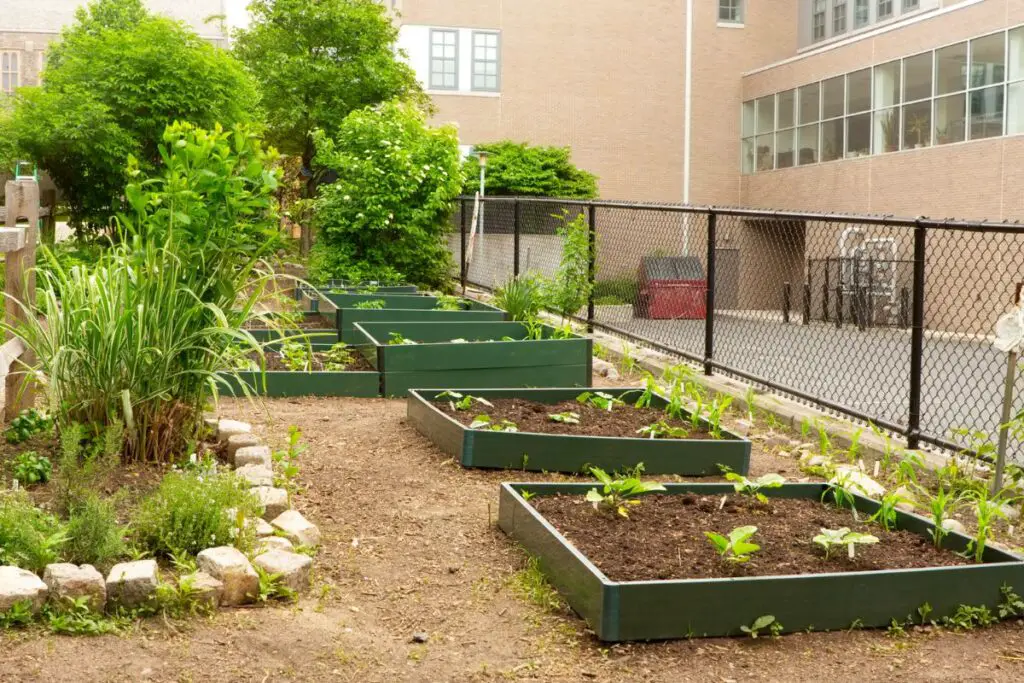
If you plan to place your raised beds over a soil surface in your existing garden, you must till the soil a bit before putting the bed.
The soil becomes hard and dry over time when you don’t work much with the garden.
Such soils are difficult to work out.
When you put the bed over such places, the water you provide drains from your bed’s soil but accumulates beneath the bed at the bottom due to hardness and compactness.
It will further lead to overwatering and root rot.
But, if you till the soil and make it flexible, the water will easily drain from the ground soil and avoid accumulation.
Plants with deep roots grow into the soil beneath the soil and will stay away from overwatering.
As a result, there will be no drainage issues.
Not adding drainage materials at the bottom of the bed soil
When beginners make raised beds, they don’t add enough drainage materials at the bottom of the bed.
That is why the beds suffer a lot from drainage issues.
Don’t forget to add materials like stones, gravel, granites, etc., at the base of the bed before adding soil.
Ensure that the drainage materials layer is at least 3 inches deep.
You may also increase the layer if the raised bed is higher.
Also read: 17 Materials To Put In Bottom Of Raised Bed? (Cheap & Best Alternatives)
Using poor quality soil
When beginners create raised beds, they assume that they can use any soil since raised beds can handle drainage.
But that is not the fact.
You must always use well-drained soil despite using raised beds for your plants.
A good soil mix is equal parts of soil and compost.
Compost is beneficial for both moisture retention and drainage.
Shallow beds
You can make both shallow and tall raised beds, but there is a limit to making shallow beds.
The bed should not be so shallow that it touches the ground surface.
If that is the case, then making a separate bed for your plants is baseless.
Despite creating the bed, your plants will not benefit from raised beds.
So, ensure that the bed you create for your plants is at least 6-12 inches deep.
Also read: How Deep Should A Raised Garden Bed Be? (With 40 Examples)
Not leveling the slope areas
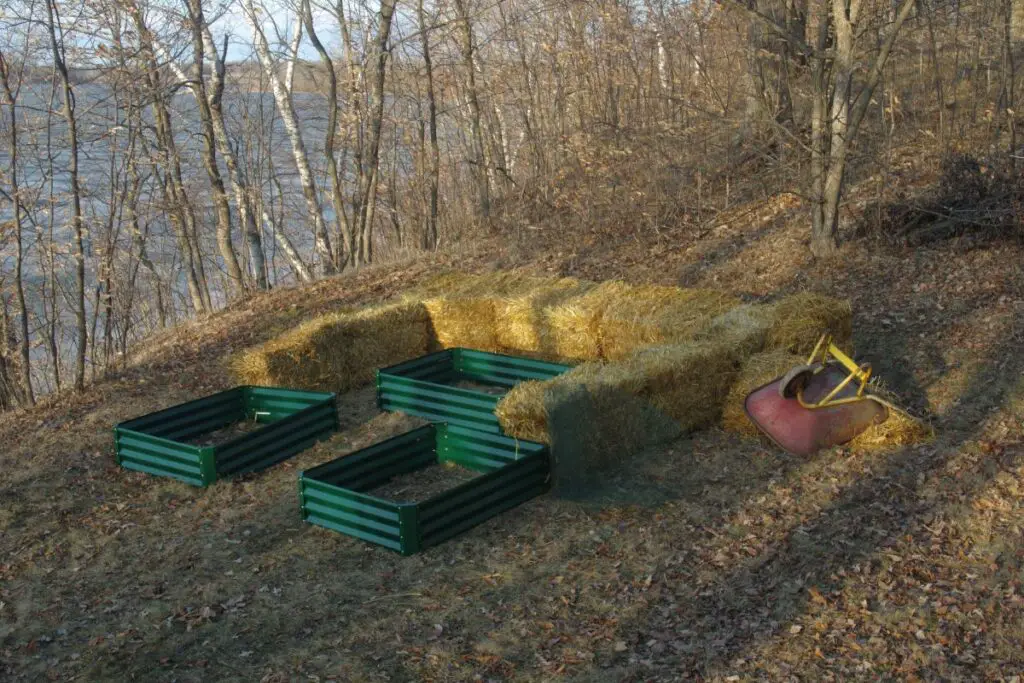
While keeping the raised beds over a sloped area, leveling the bed is important.
Raised beds absorb water unevenly.
The water drains downwards due to gravity but accumulates at the bottom.
In contrast, the upper part of the soil around the plants remains moistureless and extremely dry.
As a result, the plants can suffer both overwatering and underwatering.
So, before you place the raised beds over your sloped landscapes, consider leveling the soil bed by digging the soil of the location where you have planned to put your bed.
Also read: Can You Build A Raised Bed On A Slope? (+How To Level)
Other tips to improve the drainage of raised beds
Here are some simple tips to improve the drainage of your raised beds:
Improve soil quality
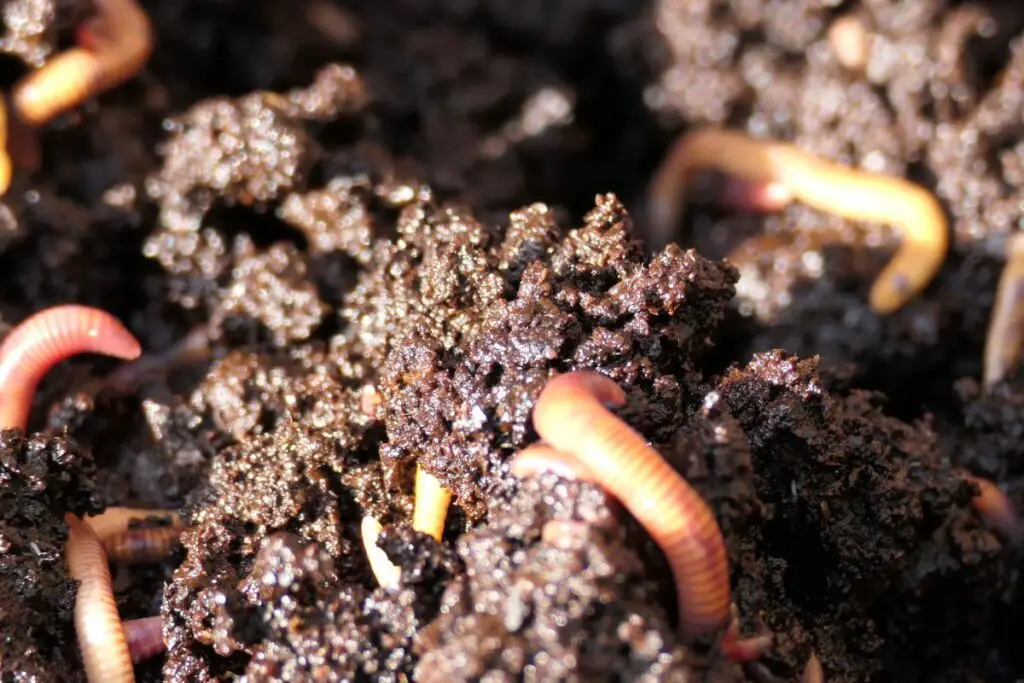
To receive good drainage for your raised beds, improve the quality of your soil.
A good mix is soil and compost.
Another good soil mix that greatly helps in drainage is:
Perlite is a great drainage material that can keep your plants from overwatering and root rot.
The soil mix will be lightweight, loose, and well-aerated, thus ideal for most plants and vegetables.
You can also use river sand instead of perlite.
But, wash the sand well before use as there can be a risk of salt.
You may replace compost instead of peat moss.
Also read: 7 Best DIY Raised Bed Soil Mix: A Step-by-step Guide
Layer the soil
Clay soil is highly responsible for poor drainage.
Their particles are very compact and wet, making the soil hard and sticky.
You can correct the condition by adding sand with clay soil.
Since sand is a great drainage material, it will highly improve the drainage of the raised beds.
Eliminate standing water
Getting rid of the accumulated water is a great way to improve drainage, especially when there is rain or excessive watering.
To eliminate the standing water:
- Loosen the soil by adding compost and manure. Mix the ingredients very well to prevent soil tightness and encourage drainage.
- Dig the soil and aerate it so that it becomes loose and flexible. The more flexible the soil is, the better the drainage will be.
- Try to remove the heavy materials like straws and leaves you have used for mulches for some time to improve the drainage. Mulching retains moisture highly. If your soil is already very well-retained, you don’t have to add extra mulch for now.
- You can keep rain barrels to collect the rainwater to prevent water stagnation in the ground.
- Create French drains around your raised beds so that the runaway or drained water gets collected.
Final thoughts
Indeed raised beds can improve the drainage, but you must make separate drainage systems for the raised beds.
The raised beds will require drainage for the plants’ good health. Use good quality soil, add drainage materials like perlite, compost, stones, and granites at the bottom of the bed, and eliminate standing water.
No matter where you put your raised beds, you must add drainage materials for proper drainage. Besides, you should also use well-drained soil for better results.
Reference: ScienceDirect, American Society of Agronomy, Noble Research Institute, Soil for Raised Beds, Raised Bed Gardening.
